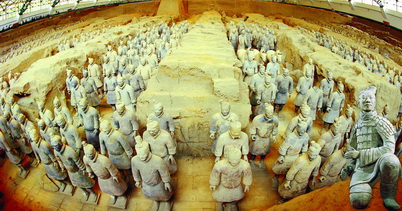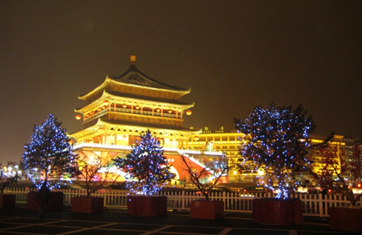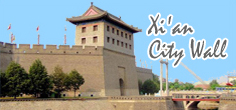发布时间: 2016年04月15日

古城西安是绝佳的雅思口语话题素材库,如果大家去西安旅游的话,你们会发现哪里遍地的美食、风景和淳朴的民风是最好的口语素材,这次中国辩论公开赛的组委会非常贴心的为参赛者整理了一批西安当地耳熟能详的食物和经典,大家就好好领略一下吧。
Travel
The Terra Cotta Warriors and Horses 秦始皇兵马俑

The Terra Cotta Warriors and Horses are the most significant archaeologic excavations of the 20th century. It is a sight not to be missed by any visitor to China.
Upon ascending the throne at the age of 13 (in 246 BC), Qin Shi Huang, later the first Emperor of all China, had begun to work for his mausoleum. It took 11 years to finish. It is speculated that many buried treasures and sacrificial objects had accompanied the emperor in his after life. A group of peasants uncovered some pottery while digging for a well nearby the royal tomb in 1974. It caught the attention of archaeologists immediately.
The State Council authorized to build a museum on site in 1975. When completed, people from far and near came to visit. Xi’an and the Museum of Qin Terra Cotta Warriors and Horses have become landmarks on all travelers' itinerary.
Life size terracotta figures of warriors and horses arranged in battle formations are the star features at the museum. They are replicas of what the imperial guard should look like in those days of pomp and vigor.
Altogether over 7,000 pottery soldiers, horses, chariots, and even weapons have been unearthed from the site. Most of them have been restored to their former grandeur.
The Terra Cotta Warriors and Horses is a sensational archaeological find of all times. It has put Xi’an on the map for tourists. It was listed by UNESCO in 1987 as one of the world cultural heritages.Address: Lintong District, Xi’an, Shaanxi
The Big Wild Goose Pagoda 大雁塔

Big Wild Goose Pagoda, situated in the Da Ci'en Temple, is one of the famous Buddhist pagodas in China about 4 kilometers from the urban center.
Originally built in 589 A.D. in the Sui dynasty, the temple was named Wu Lou Si Temple till 648 A.D. when Emperor Li Zhi, then still a crown prince, sponsored a repair project on the temple.
This was a symbol of thanksgiving to his mother for her kindness, after she had suffered an early death. The temple then assumed the present name Temple of Da Ci'en (Thanksgiving). The temple was a place of grand extent in the Tang dynasty. However, it went into gradual decay after the downfall of the Tang dynasty. The halls and rooms that have survived the age are structures that were built in the Ming dynasty.
The Tang Regime gave orders to build a chamber for the translation of Buddhist scriptures in an effort to have the then widely renowned Master Xuanzang (Monk Tripitaka) agree to be the head of the temple.
The Bell Tower 西安钟楼

The Bell Tower, a classical building with carved beams and painted rafters, has been served as the symbol of Xi’an. It stands in the center of the downtown area where the north street, the south street, the west street and the east street meet. And the tower house is a huge bell which in ancient times was used to strike the time every morning. This is how the tower got its name. now it is an important historical monument in Shaanxi Province.
The Bell tower was first built in 1384 during the Ming dynasty. It was moved to its present site in 1582 as a result of the city‘s expansion program.
Xi’an City Wall 西安城墙

The Xi'an City Wall is not only the most complete architecture well preserved of ancient Chinese burghs but also the largest in size and integral ancient military fort of the world.
During the transition period from spring to summer in 1997, US President Clinton took the first stop of his China journey in Xi'an and sang high praise for the ancient city wall and the gates.
The ancient Xi'an City Wall came into being on the original base of the capital of Tang Dynasty, in the heat of constructing under the Chief Commander Pu Ying's supervision.
The Xi'an City Wall augmented in Ming Dynasty measures 12 meters high, 12 to 14 meters wide on the top, 15 to 18 meters wide at the bottom with a total length of 13.7 kilometers. There is a watchtower in every 120 meters, outstanding with a same height leveling with the wall to help soldiers kill enemies that are climbing the wall.
There is a suspense bridge in front of the gate. Raising the bridge means, the way to enter the city or go out are cut out. In the Ming Dynasty the fort had become an grand and precise defense system and now is still a better ancient fort kept intact than any other.
The ancient Xi'an fort has not only displayed the Chinese talent showing in military construction but also provided valuable information to study history, military developments and architecture structure.
Now,the ancient city wall and the city gates are not only the shining stars of history but also historic wonders attracting tourists.
编辑推荐:
免费资料下载排行